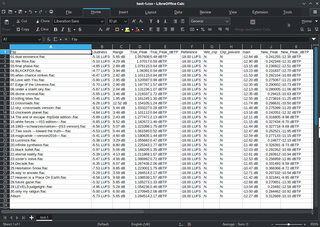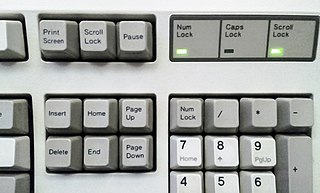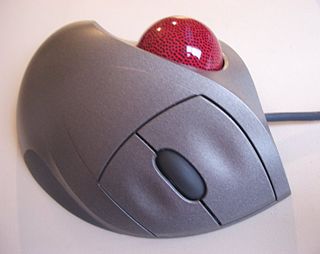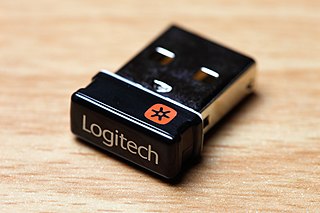
A computer mouse is a hand-held pointing device that detects two-dimensional motion relative to a surface. This motion is typically translated into the motion of the pointer on a display, which allows a smooth control of the graphical user interface of a computer.

A spreadsheet is a computer application for computation, organization, analysis and storage of data in tabular form. Spreadsheets were developed as computerized analogs of paper accounting worksheets. The program operates on data entered in cells of a table. Each cell may contain either numeric or text data, or the results of formulas that automatically calculate and display a value based on the contents of other cells. The term spreadsheet may also refer to one such electronic document.

Scroll Lock is a lock key on most IBM-compatible computer keyboards. Depending on the operating system, it may be used for different purposes, and applications may assign functions to the key or change their behavior depending on its toggling state. The key is not frequently used, and therefore some reduced or specialized keyboards lack Scroll Lock altogether.

A trackball is a pointing device consisting of a ball held by a socket containing sensors to detect a rotation of the ball about two axes—like an upside-down ball mouse with an exposed protruding ball. Users roll the ball to position the on-screen pointer, using their thumb, fingers, or the palm of the hand, while using the fingertips to press the buttons.

A game controller, gaming controller, or simply controller, is an input device or input/output device used with video games or entertainment systems to provide input to a video game. Input devices that have been classified as game controllers include keyboards, mice, gamepads, and joysticks, as well as special purpose devices, such as steering wheels for driving games and light guns for shooting games. Controllers designs have evolved to include directional pads, multiple buttons, analog sticks, joysticks, motion detection, touch screens and a plethora of other features.

A scrollbar is an interaction technique or widget in which continuous text, pictures, or any other content can be scrolled in a predetermined direction on a computer display, window, or viewport so that all of the content can be viewed, even if only a fraction of the content can be seen on a device's screen at one time. It offers a solution to the problem of navigation to a known or unknown location within a two-dimensional information space. It was also known as a handle in the very first GUIs. They are present in a wide range of electronic devices including computers, graphing calculators, mobile phones, and portable media players. The user interacts with the scrollbar elements using some method of direct action, the scrollbar translates that action into scrolling commands, and the user receives feedback through a visual updating of both the scrollbar elements and the scrolled content.

An optical mouse is a computer mouse which uses a miniature camera and digital image processing to detect movement relative to a surface. Variations of the optical mouse have largely replaced the older mechanical mouse and its need for frequent cleaning.

A pointing stick is a small analog stick used as a pointing device typically mounted centrally in a computer keyboard. Like other pointing devices such as mice, touchpads or trackballs, operating system software translates manipulation of the device into movements of the pointer on the computer screen. Unlike other pointing devices, it reacts to sustained force or strain rather than to gross movement, so it is called an "isometric" pointing device. IBM introduced it commercially in 1992 on its laptops under the name "TrackPoint", and patented an improved version of it in 1997. It has been used for business laptops, such as Acer's TravelMate, Dell's Latitude, HP's EliteBook and Lenovo's ThinkPad.

A touchpad or trackpad is a type of pointing device. Its largest component is a tactile sensor: an electronic device with a flat surface, that detects the motion and position of a user's fingers, and translates them to a position on a screen, to control a pointer in a graphical user interface. Touchpads are common on laptop computers, contrasted with desktop computers, where mice are more prevalent. Trackpads are sometimes used on desktops, where desk space is scarce. Because trackpads can be made small, they can be found on personal digital assistants (PDAs) and some portable media players. Wireless touchpads are also available, as detached accessories.

A scroll wheel is a wheel used for scrolling. The term usually refers to such wheels found on computer mice. It is often made of hard plastic with a rubbery surface, centred around an internal rotary encoder. It is usually located between the left and right mouse buttons and is positioned perpendicular to the mouse surface. Sometimes the wheel can be pressed left and right, which is actually just two additional macros buttons.
Microsoft IntelliPoint is the Microsoft-branded software driver for the company's hardware mice. Microsoft has released versions for both Windows and Mac OS X. It has been succeeded by Microsoft Mouse and Keyboard Center, which combines IntelliType with IntelliPoint.

IntelliMouse is a series of computer mice from Microsoft. The IntelliMouse series is credited with a number of innovations; Microsoft was among the first mouse vendors to introduce a scroll wheel, an optical mouse, and dedicated auxiliary buttons on the side of the mouse. They use IntelliPoint drivers and its main competitor through the years has been Logitech.

Pen computing refers to any computer user-interface using a pen or stylus and tablet, over input devices such as a keyboard or a mouse.
HIDPoint is proprietary Linux software for USB Keyboards and Mice. Currently it supports most Logitech keyboards and mice. It runs on many Linux distributions such as RHEL, SUSE, Ubuntu and Fedora. HIDPoint has been designed to give users using USB Mice and Keyboards the same experience they get when using these devices on Microsoft Windows.
A rotational mouse is a type of computer mouse which attempts to expand traditional mouse functionality. The objective of rotational mice is to facilitate three degrees of freedom (3DOF) for human-computer interaction by adding a third dimensional input, yaw, to the existing x and y dimensional inputs. There have been several attempts to develop rotating mice, using a variety of mechanisms to detect rotation.

In computing, an input device is a piece of equipment used to provide data and control signals to an information processing system, such as a computer or information appliance. Examples of input devices include keyboards, computer mice, scanners, cameras, joysticks, and microphones.
Hillcrest Labs was a sensor processing technology company that developed free space motion-control technology and the first motion-controlled remote for television. Hillcrest also invented the first graphical zoomable interface for television and Kylo, the first Web browser optimized for television. The company, based in Rockville, Maryland, was acquired by CEVA in July 2019.

The Logitech Unifying Receiver is a small dedicated USB wireless receiver, based on the nRF24L-family of RF devices, that allows up to six compatible Logitech human interface devices to be linked to the same computer using 2.4 GHz band radio communication. Receivers that are bundled with a Logitech product are paired with the device at the factory. When purchasing a replacement receiver or connecting multiple devices to one receiver, pairing requires the free-of-charge Logitech Unifying software, available for Microsoft Windows and Mac OS X. On Linux the Solaar software can be used to adjust the configurations. Although not compatible with Bluetooth, devices pair to Unifying Receivers in a similar way. Peripherals remain paired, and can then be used on systems not supporting the software. Logitech receivers compatible with the Unifying protocol can be identified by the orange Unifying logo, which distinguishes them from Logitech Nano receivers of similar appearance, which pair in a similar manner but only with a single device, without using the Unifying protocol.

KYE Systems Group, or KYE, an abbreviation of Kung Ying Enterprises, is a Taiwanese computer peripheral manufacturer that designs and manufactures and markets human interface devices such as mice under their own brand, Genius. The company also manufactures on an OEM basis for companies such as HP and Microsoft. The company was founded in 1983 and has opened offices internationally.














